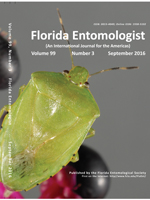Sugarcane beetle (Euetheola rugiceps LeConte; Coleoptera: Scarabaeidae) is a pest of turfgrass in the southeastern United States. This study was conducted to evaluate the toxicity of 5 products for sugarcane beetle pest management in managed bermudagrass (Cynodon dactylon L.; Poaceae). Spring and fall populations of sugarcane beetle adults were exposed to 4 active ingredients and combinations (bifenthrin, bifenthrin plus clothianidin, carbaryl, clothianidin, and dinotefuran) under greenhouse conditions. At 7 d after treatment, there were no significant differences among insecticide treatments applied to spring beetles at either a low or a high field rate, although all insecticides caused a significant increase in beetle mortality relative to untreated (control) beetles. In contrast, bifenthrin caused significantly greater control of fall populations at the low field rate compared with other treatments. Target population (spring or fall) appears to have more impact on pesticide efficacy than either product selection or application rate.
How to translate text using browser tools
1 September 2016
Efficacy of Five Insecticides Targeting Spring and Fall Populations of Sugarcane Beetle Adults
Terri Billeisen,
Rick Brandenburg

Florida Entomologist
Vol. 99 • No. 3
September 2016
Vol. 99 • No. 3
September 2016
césped
chemical control
control químico
Euetheola rugiceps
IPM
MIP
turfgrass




